All About Brown, Root Beer and Amber Sea Glass
A piece of earth-toned sea glass is so much more than brown…
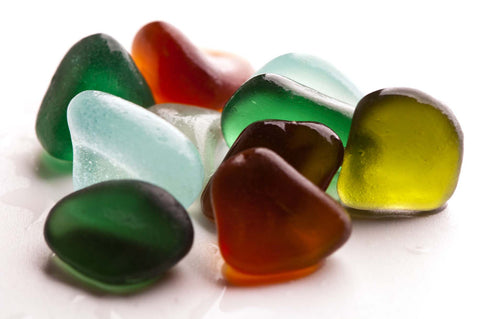 Each piece seems to capture the light in a slightly different way - holding it deeply with its own unique glow. The “brown” family of sea glass ranges from light, pale amber to a rich, dark brown. Each variation in tone reflects a distinct history.
Each piece seems to capture the light in a slightly different way - holding it deeply with its own unique glow. The “brown” family of sea glass ranges from light, pale amber to a rich, dark brown. Each variation in tone reflects a distinct history.
I like to call these colors, and the olive to deep greens my “Boozie” sea glass, as most come from adult beverage bottles… whether the deep brown amber of an almost black colonial rum bottle, to the  golden glow of more modern beer and ale bottles, it’s fascinating to think about the quiet evenings or wild nights these small sea glass shards were once a part of!
golden glow of more modern beer and ale bottles, it’s fascinating to think about the quiet evenings or wild nights these small sea glass shards were once a part of!
We have sulfur to thank for creating a honey amber tone in glass. Iron and carbon oxides darken the glass until it reaches an almost black. It can be tough to spot an almost black piece of Sea Glass among the pebbles and rocks of a Sea Glass beach, but if the sun hits them just right, you’ve found a treasure!
Amber Sea Glass
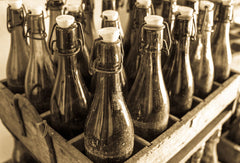 Amber is the most popular glass color currently made due to our love of all things beer, however, most Sea Glass is at least decades, and sometimes over 100 years old… but still comes from beer and other alcohol bottles!
Amber is the most popular glass color currently made due to our love of all things beer, however, most Sea Glass is at least decades, and sometimes over 100 years old… but still comes from beer and other alcohol bottles!
Among Sea Glass enthusiasts, there isn’t just one “Amber.” Amber ranges from the lightest golden to the vibrant almost orange. The amber glass that was created two centuries ago is very different than the dark brown of the modern beer bottle. Golden brown sea glass - sometimes with a reddish glow and nick-named "Root Beer" - is more likely to come from vintage products than contemporary beer bottles. Medicines, bleach and Lysol used to come in amber bottles. So did tobacco snuff.
Golden brown sea glass - sometimes with a reddish glow and nick-named "Root Beer" - is more likely to come from vintage products than contemporary beer bottles. Medicines, bleach and Lysol used to come in amber bottles. So did tobacco snuff.
Amber was popular in pressed glass that was made just after the Civil War. It was also used to make Depression glass from the 1930s to the 1950s. If you find a piece of very light amber sea glass, it could have come from one of these decorative pieces.
Amber Sea Glass – Five Fascinating Facts
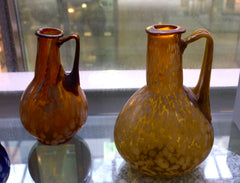 1. Amber Sea Glass isn’t just amber, it can be yellow amber, golden amber, red amber, honey amber and even “old” amber – a name for lighter amber with a greenish tint.
1. Amber Sea Glass isn’t just amber, it can be yellow amber, golden amber, red amber, honey amber and even “old” amber – a name for lighter amber with a greenish tint.
2. Carbon, in the form of coal, can be added to glass to create an amber color. 3. The ancient Romans where quite fond of amber glass for flasks and other vessels that held liquid.
3. The ancient Romans where quite fond of amber glass for flasks and other vessels that held liquid.
4. You can still find Amber Sea Glass with the faint trace of embossing dating to the late 1800’s.
5. Early poison bottles in amber and blue were ribbed to alert you to the fact that this bottle contained something you shouldn’t drink! Often they had “Not to be Taken” embossed on them as well!
Amber Sea Glass Jewelry
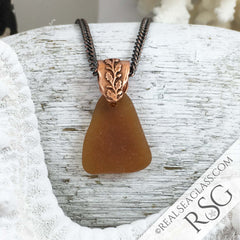 With its rich golden glow, Amber Sea Glass jewelry can be particularly alluring. When it’s wet, it may take on the slightly reddish hue of root beer. Its tone can change as it catches the light. What looks like a tan piece of glass in some lights can sparkle with golden radiance in others. It can take on a depth that isn’t seen in some of the lighter colored sea glass.
With its rich golden glow, Amber Sea Glass jewelry can be particularly alluring. When it’s wet, it may take on the slightly reddish hue of root beer. Its tone can change as it catches the light. What looks like a tan piece of glass in some lights can sparkle with golden radiance in others. It can take on a depth that isn’t seen in some of the lighter colored sea glass.
Amber creates images of richness and prestige. It conveys illumination, wealth,  warmth and wisdom. Amber is the bridge between orange’s exuberance and brown’s steadiness, encouraging a healthy balance between the two.
warmth and wisdom. Amber is the bridge between orange’s exuberance and brown’s steadiness, encouraging a healthy balance between the two.
Reach for Amber Sea Glass jewelry when you are looking to feel energetic, positive and self-assured. Amber speaks to history, tradition and prosperity… which makes sense, given its popularity over the centuries.
Brown & Root Beer Sea Glass
 Brown and Root Beer colored sea glass almost always comes from beer bottles. It might be old, or it might be a few decades old. One way to estimate its age is to look at its size and shape. A smooth, circular piece of glass is likely to be older than a jagged, triangular shard.
Brown and Root Beer colored sea glass almost always comes from beer bottles. It might be old, or it might be a few decades old. One way to estimate its age is to look at its size and shape. A smooth, circular piece of glass is likely to be older than a jagged, triangular shard.
Have you ever wondered why beer is bottled in dark hued glass? It all comes down to those pesky UV rays. Early bottlers (and by early, we mean 1600’s) soon discovered that having a long-neck bottle was best when working with a carbonated beverage. There was a lot more than one beer “explosion” on the road to the development of a long-neck bottle, but back to the color issue…
You see, sunlight quickly sours beer. It wasn’t too long before glass blowers started adding oxides to the glass to give it a dark amber to dark brown color. And this tradition continues to today, as those same UV rays are still lurking to attack your favorite summer beverage! Fun factoid: when World War II came around, brown glass was in high demand. Beer manufacturers couldn’t always get their hands on the product, so they used green instead, and for some brands, the tradition continues.
Fun factoid: when World War II came around, brown glass was in high demand. Beer manufacturers couldn’t always get their hands on the product, so they used green instead, and for some brands, the tradition continues.
Green glass doesn’t do the job that brown glass does… but it’s a whole lot better  than clear glass at protecting beer, rum and the like. Beer that comes in a clear glass bottle is more likely to turn sour as a reaction to UV light than beer in darker bottles. (The light in the refrigerator does turn off when we shut the door… right?) Today, brown is still the most popular color for craft beer bottles, as they harken back to centuries of practicality and tradition.
than clear glass at protecting beer, rum and the like. Beer that comes in a clear glass bottle is more likely to turn sour as a reaction to UV light than beer in darker bottles. (The light in the refrigerator does turn off when we shut the door… right?) Today, brown is still the most popular color for craft beer bottles, as they harken back to centuries of practicality and tradition.
Brown sea glass doesn’t always come from modern bottles. Vintage root beer was packaged in brown glass bottles to preserve its freshness. Old and new whiskey bottles can look brown or amber after spending years in the ocean. And don’t forget those wonderful, old-time pharmacy bottles.
Brown Sea Glass – Five Fascinating Facts
 1. The oldest pieces of Brown Sea Glass often have bubbles because the glass was hand-blown.
1. The oldest pieces of Brown Sea Glass often have bubbles because the glass was hand-blown.
2. True centuries-old brown bottles – mostly used for beer and rum – don’t usually stand straight! They were free-blown and lean to one side or the other… kinda ironic, if you know what I mean!
3. The oldest Brown Sea Glass can vary in thickness due again to its hand-blown nature.
4. In the 1920’s, when automatic bottle making machines were in wide use, color variations in brown glass became far less common – the super dark and quite light browns were all but eliminated due to standardization in glass factories.
5. Yes, it’s true! Clorox bleach used to come in heavy brown glass jugs! Image courtesy of Clorox.
Brown Sea Glass Jewelry
 Brown is the color of earth, home and foundations. It encourages stability, approachability and comfort. Brown is deeply tied to all things natural and organic, and a feeling of wholeness and grounding.
Brown is the color of earth, home and foundations. It encourages stability, approachability and comfort. Brown is deeply tied to all things natural and organic, and a feeling of wholeness and grounding.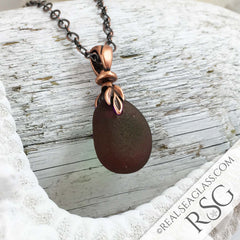 Brown is said to boost respect, communications and friendships. It is also valued for its ability to extend endurance and confidence.
Brown is said to boost respect, communications and friendships. It is also valued for its ability to extend endurance and confidence.
Brown Sea Glass jewelry is perfect for someone who wants to feel calm, classy, warm, genuine and approachable. It is down-to-earth – literally, exuding a quite strength and honest reassurance. Brown Sea Glass pairs effortlessly with any earth or neutral color – whether bright or muted.
Hunting Brown, Root Beer & Amber Sea Glass
 While Sea Glass isn’t a gemstone, it does, like gemstones, develop as nature exerts its force on the minerals that make up glass.
While Sea Glass isn’t a gemstone, it does, like gemstones, develop as nature exerts its force on the minerals that make up glass.
And it is to nature that we look for these tiny treasures. Anyone who goes out on the beach to search for Sea Glass knows there’s no promise that hours of hunting will lead to a discovery - after all it's called Sea Glass hunting, not Sea Glass finding! But, you can increase your chances of finding one of these gems with just a few tips:
1. Try getting to the beach at sunrise, when the rays of the sun may spark and inner-glow in deeply hued Sea Glass.
2. Look among the rocks carefully for a “rock” without a lot of color variation… it just might be a deep brown Sea Glass shard.
3. Get to the beach right after a storm, when waves have shifted sand and rocks, perhaps revealing a hidden treasure.
And, if you’d like to buy a golden Sea Glass treasure, make sure it’s Real Sea Glass. Unfortunately, the rise in the production of cheap, manufactured frosted glass has led to some representing it as Sea Glass. When you purchase Real Sea Glass jewelry, you’re supporting those who spend hours and hours searching for these rare nuggets, and you have a true Bit of the Beach.




